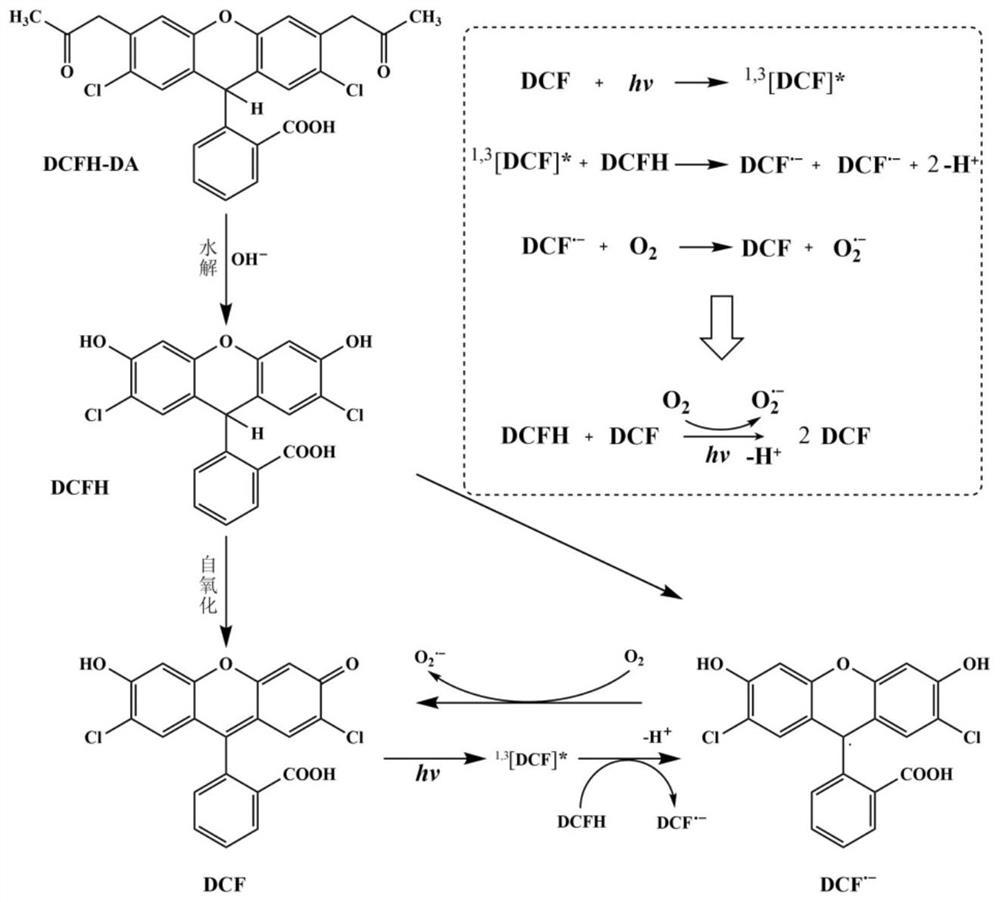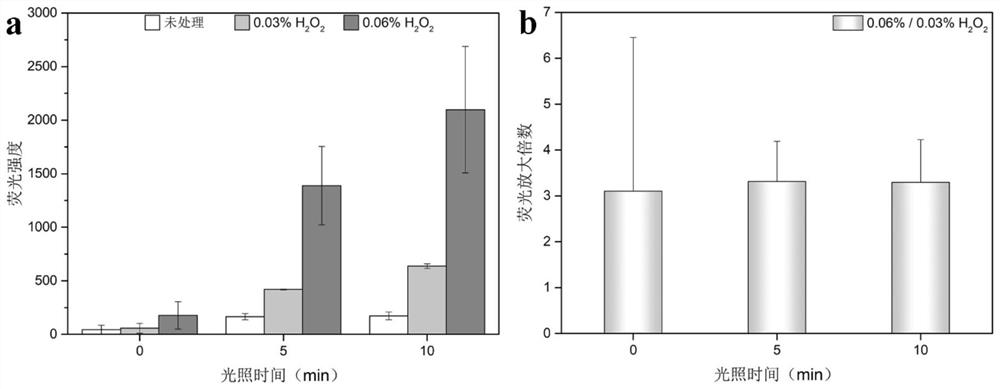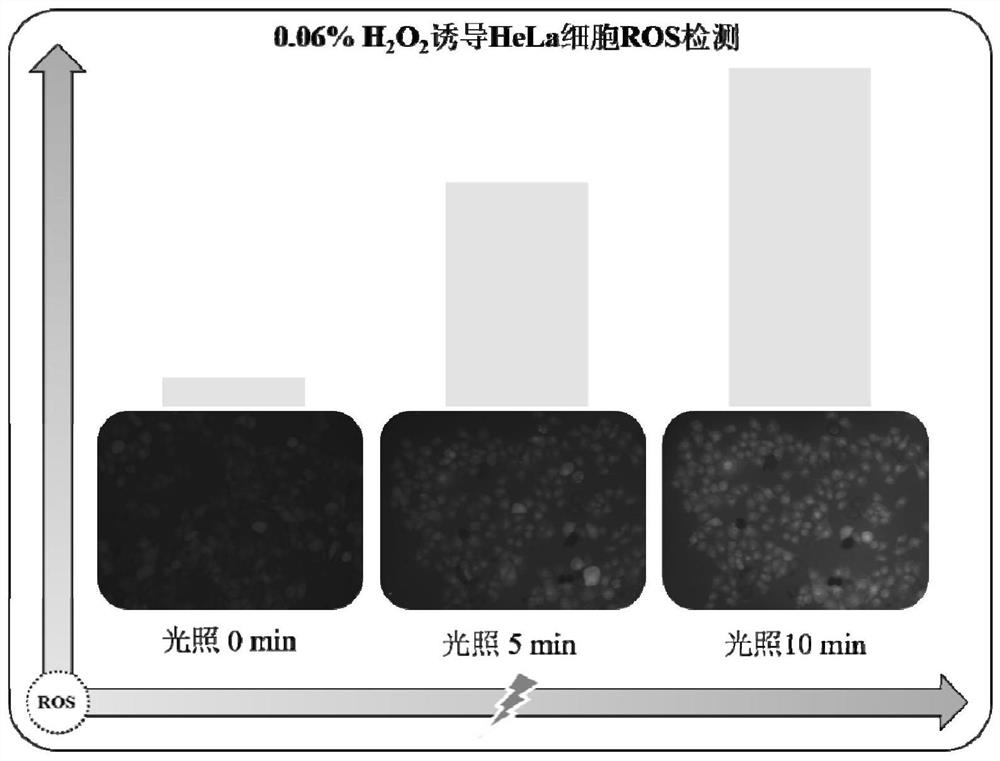Low-concentration ROS detection method and application thereof
A detection method and low-concentration technology, applied in measuring devices, using chemical indicators for analysis, instruments, etc., can solve problems such as inability to penetrate cell membranes, decrease in probe content, etc., to achieve increased fluorescence intensity, enhanced fluorescence intensity, and detection numerically significant effect
- Summary
- Abstract
- Description
- Claims
- Application Information
AI Technical Summary
Problems solved by technology
Method used
Image
Examples
Embodiment 1
[0045] Example 1 stimulates HeLa cells to generate ROS
[0046] (1) Use H 2 o 2 Stimulation of ROS production in HeLa cells
[0047] ①Use a pipette gun to absorb 89mL DMEM high-glucose medium, 10mL fetal bovine serum, and 1mL penicillin-streptomycin double antibody solution to prepare cell growth medium, and adjust the pH to 0.1M NaOH solution or 12M HCl solution by dropping 7.0.
[0048] ②The human cervical cancer cell line HeLa was selected as the cell line used in the experiment, and the cells were inoculated into a 96-well plate one day before the experiment, with 15,000 cells per well. The cells were grown on the wall for 12 hours until the confluence of the cells reached 50-70%.
[0049] ③ Add different volumes of H 2 o 2 Stimulate cells (make H 2 o 2 The concentrations in the system are respectively 0.03%, 0.06%), and cultured in the dark for 30 minutes in a cell culture incubator at 37°C.
[0050] ④Remove the solution after 30 min of stimulation, wash the cell...
Embodiment 2
[0056] Embodiment 2 detects H 2 o 2 Stimulated ROS in HeLa cells
[0057] ①The DCFH-DA solution (final concentration is 10 μM) diluted in high-glucose DMEM serum-free medium (containing 1% penicillin-streptomycin double antibody solution) was added to the oxidatively damaged HeLa cells in step (1) of Example 1, and passed Add 0.1M NaOH solution or 12M HCl solution dropwise to adjust the pH to 7.0, and incubate in the dark for 30 minutes.
[0058] ②Remove the solution after incubation for 30 minutes, and wash with 1×PBS (0.01M, pH=7.4) buffer solution for 2 to 3 times to fully remove the DCFH-DA solution that has not entered the cells, and obtain the sample to be tested.
[0059] ③ The sample to be tested is irradiated with LED light, the illumination time is 5min and 10min respectively, and the optical power density is 13.40mW / cm 2 .
[0060] ④ Use a multifunctional microplate reader to detect the fluorescence signal value in each well plate, wherein the excitation wavelen...
Embodiment 3
[0062] Example 3 Detection of ROS in HeLa cells stimulated by polystyrene plastic particles
[0063] ①The DCFH-DA solution (final concentration is 10 μM) diluted in high-glucose DMEM serum-free medium (containing 1% penicillin-streptomycin double antibody solution) was added to the oxidatively damaged HeLa cells in step (2) of Example 1, and passed Add 0.1M NaOH solution or 12M HCl solution dropwise to adjust the pH to 7.0, and incubate in the dark for 30 minutes.
[0064] ② After incubation for 30 minutes, remove the solution and wash with 1×PBS (0.01M, pH=7.4) buffer solution for 2-3 times to fully remove the DCFH-DA solution that did not enter the cells.
[0065] ③The solution to be tested is irradiated with LED light, the illumination time is 5min and 10min respectively, and the optical power density is 13.40mW / cm 2 .
[0066] ④ Use a multi-functional microplate reader to detect the fluorescent signal value in each well plate, wherein the excitation wavelength of the flu...
PUM
| Property | Measurement | Unit |
|---|---|---|
| wavelength | aaaaa | aaaaa |
| particle diameter | aaaaa | aaaaa |
| concentration | aaaaa | aaaaa |
Abstract
Description
Claims
Application Information
 Login to View More
Login to View More - R&D
- Intellectual Property
- Life Sciences
- Materials
- Tech Scout
- Unparalleled Data Quality
- Higher Quality Content
- 60% Fewer Hallucinations
Browse by: Latest US Patents, China's latest patents, Technical Efficacy Thesaurus, Application Domain, Technology Topic, Popular Technical Reports.
© 2025 PatSnap. All rights reserved.Legal|Privacy policy|Modern Slavery Act Transparency Statement|Sitemap|About US| Contact US: help@patsnap.com



